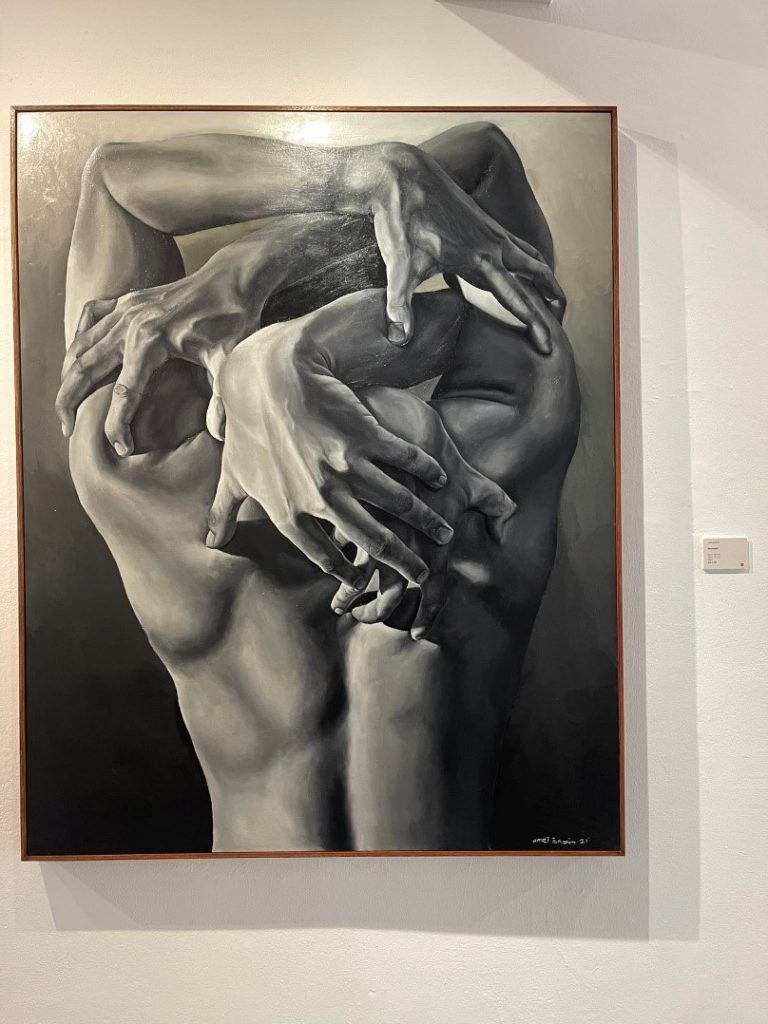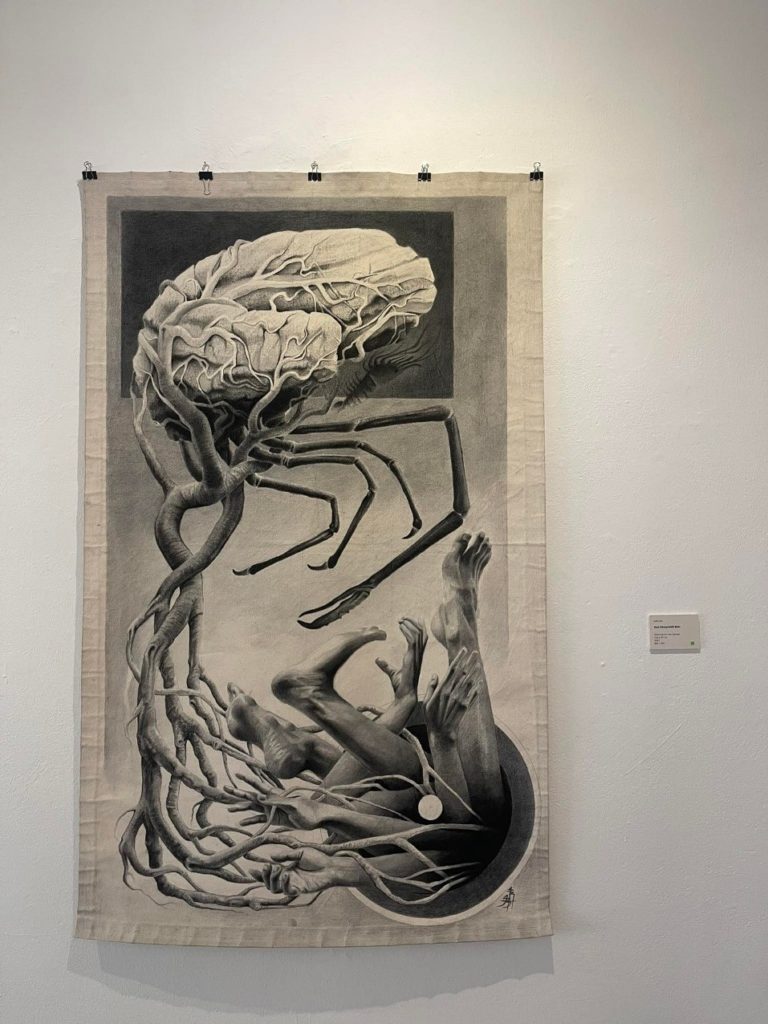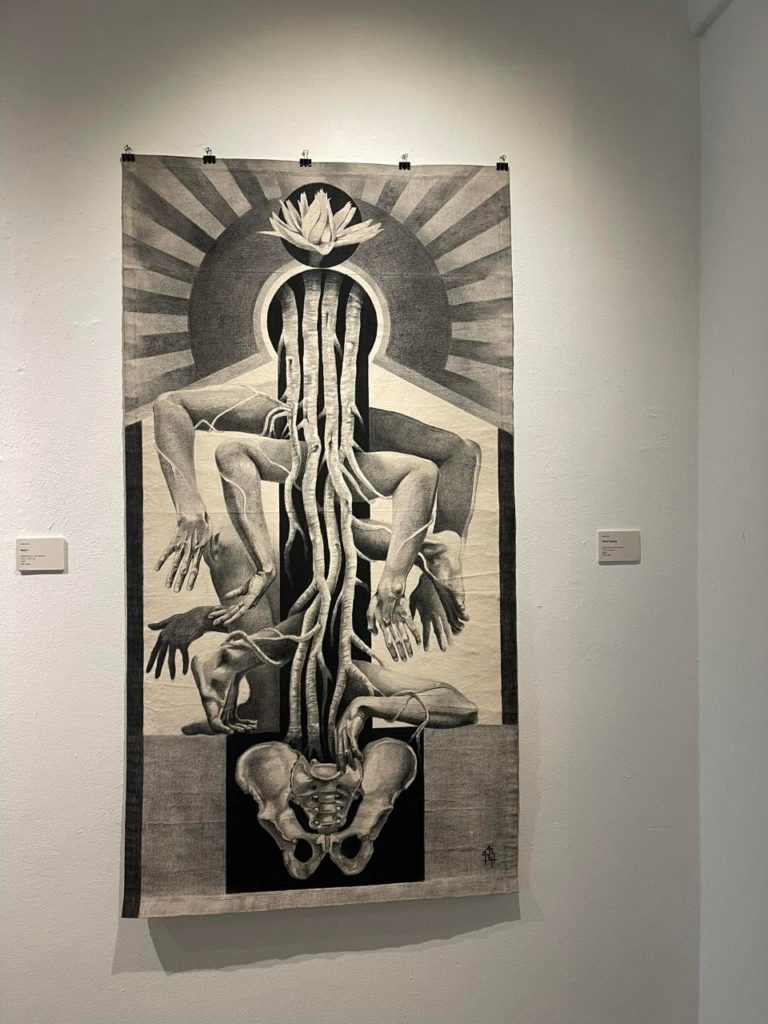In a joint exhibition by Aqim Adil and Amri Ibrahim, both artists go introspective through human anatomy and the natural world.
Story and Photos by LEE XIN YING for Lensa Seni
Since the dawn of the medium, the greyscale technique has been a classic staple in most visual media such as film and photography. In the past few decades especially, slapping on a black and white filter to appear more “in depth” and “intelligent” can often be overused and heavily satirized, but in Symbol & Gesture, the monochrome tones seemed right.

The title of the art exhibition is rather self-explanatory once you step foot into HOM Arts Trans gallery. Displayed on one side was Aqim Adil’s work, crafted with heavy geometry, surrealism and symbolism – mountains, fish and trees postured in between the flurry of human appendage, wholly cohesive despite the numerous subject matter. Drawn on raw canvas and raw cloth with charcoal, his dreamlike art style struck as almost hypnotic on the rectangular canvas, reminding me of old, mystic scrolls.
As the other half of the duo, Amri Ibrahim’s art pieces portrayed the latter part of Symbol & Gesture more heavily. All paintings were of the same, unclothed torso of an unnamed man – sometimes seen alone, sometimes with another similar person. Unlike the Eurocentric nude portraits that we are accustomed to in classic Western art, Amri’s work does not just sit still. His figures, oil on canvas, do not just mildly embrace – they grasp, clutch, seize and hug with so much ferocity that you cannot help but linger your gaze.
Both finishing their series during the MCOs of this year, Aqim mentioned that spending lockdown in the suburbs made him long for contact with nature. When coupled with his concern of deforestation and environmental violations news flooding into his life one after the next, it became his drive to depict the relationship between mother nature and mankind through his art.
In Amri’s case, his source of inspiration was scaled much smaller. To him, body language can express a lot without saying anything, including one’s state of mind. The project, which started out as an observation of Amri and his twin brother – turned into a mediation of self-reflections and contemplation.

One of Aqim’s pieces that caught my eye is Otak Udang Balik Batu. At first glance, it seemed as though something right out of a dystopian Hollywood sci-fi film, but the name of the piece was derived from a Malay idiom and proverb, combining otak udang, meaning simple-brained, with ada udang di balik batu, the literal translation being “there’s a prawn behind the rock”, or something fishy might be going on behind the scenes.
The tangle of limbs at the bottom right corner claws and entwines with the branches, with the prawn brain dangling at the top, looming over them, yet still control them. The storytelling prompted me to draw parallels – how a top percent of people is grossly accountable for the current destructive state of our environment, with oil companies and capitalist global leaders who only know to feed empty lies, synonymous with the “prawn head” above, while the rest of the world population suffers below, sucked, or pushed, into a bottomless hole of despair.
Disconnect, reconnnect
When observing a figure painting, the first thing most viewers seek out, is the face, guessing the emotions from the characters’ expressions and the feeling it is trying to convey.
However, an interesting note that tied the two artists’ works together is that there are no faces drawn – zero. Limbs, of course, are always in the frame – we see poses of hands and feet, or backs and arms interacting, but facial features are rarely in sight. At most, there is a glimpse of a side profile in Amri’s Everybody Hears but Few Listen, but the face is also buried, or clamped down by hands, apparently stuck in a tense wrangle.

The obscurity of identity can be curiously liberating. Stripped down to only gestures and muscles, it gives much more emphasis to the grapple of the figures, mirroring the emotions that the art evokes. Although we each have our own unique experiences, the piece speaks well to the universal feeling of depression, anxiousness and being unheard, which is what the artist intended.
On the gallery website, Amri stated, “Through the figurative form of art, I capture my inner struggle and project it onto canvas as a reminder to myself that, this too shall pass.”
“No man is an island” is John Donne’s way of saying all humans are interlinked, and no one is self-sufficient when humans rely so heavily on our community and everyday interaction. In a sense, connection is a theme that pulses through the entire art exhibition, illustrated in impassioned physical touch and pensive surrealist art. While Aqim confronts the fragile bond between man and nature, Amri doggedly finds different ways to converse and console with the self.
Symbol & Gesture might not mean to show us any answers, but as I strolled alone in the small art space, there lay something almost catharsis-like to me, an assurance that someone else felt the same disquiet and angst as myself at one point. As the world gradually opens up, it acts as a nudge that we may seek to forge, or reforge, our relationships with nature, the people around us, and ourselves.
Aqim Adil and Amri Ibrahim’s joint exhibition ‘Symbol and Gesture’ took place from Nov 17-27, 2021 at HOM Art Trans, Kuala Lumpur.
Lee Xin Ying is a participant in the CENDANA ARTS WRITING MASTERCLASS & MENTORSHIP PROGRAMME 2021
The views and opinions expressed in this article are strictly the author’s own and do not reflect those of CENDANA. CENDANA reserves the right to be excluded from any liabilities, losses, damages, defaults, and/or intellectual property infringements caused by the views and opinions expressed by the author in this article at all times, during or after publication, whether on this website or any other platforms hosted by CENDANA or if said opinions/views are republished on third-party platforms.
